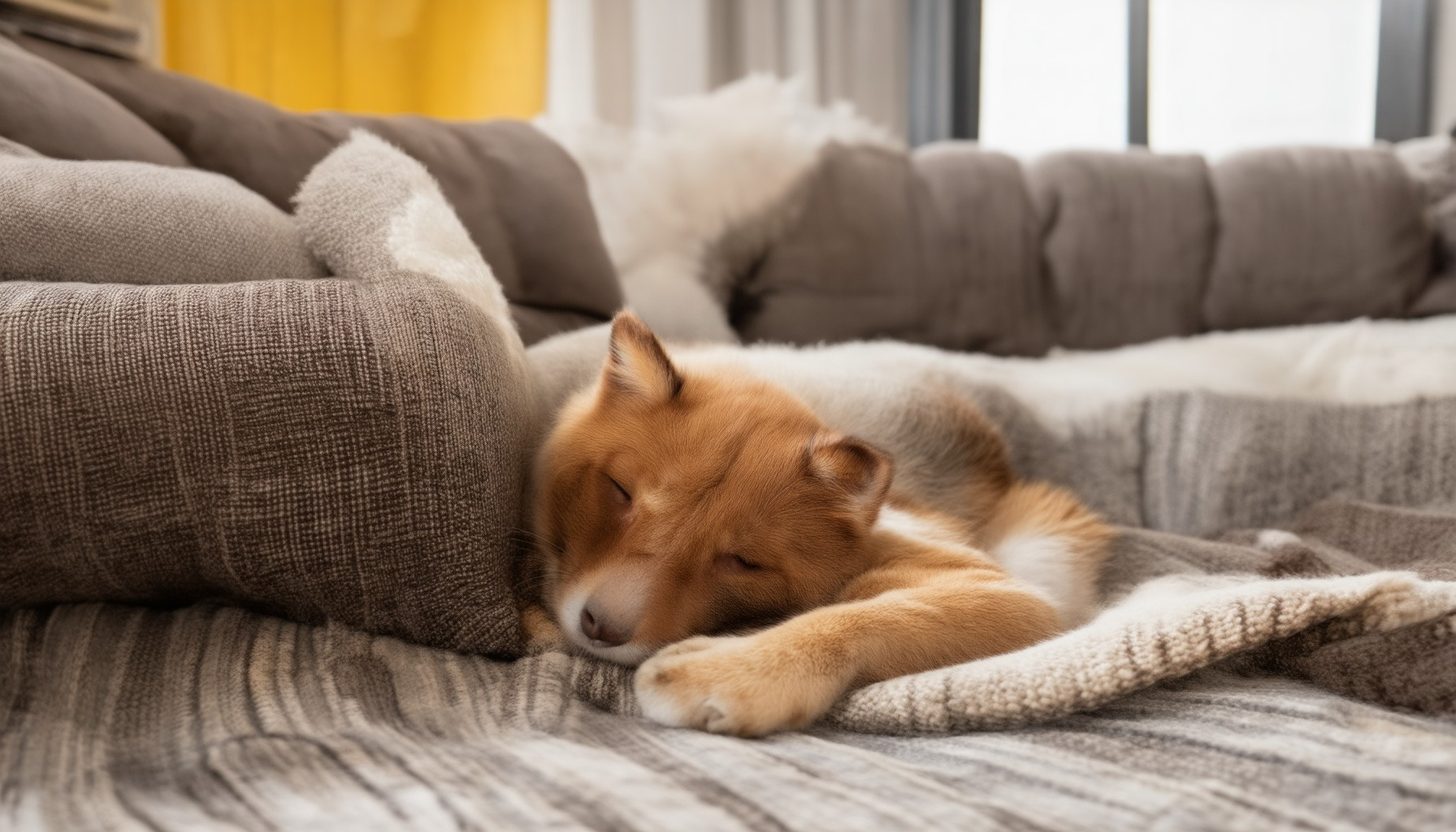Designing a home that’s as comfortable for your furry friends as it is for you is one of the most rewarding projects any pet owner can undertake. Whether you’re a dog person, a cat enthusiast, or a bird lover, creating a pet-friendly space requires thoughtful consideration of both functionality and style. Challenges like pet scratches, odors, and messes can quickly turn a cozy space into a chaotic one. However, with the right strategies, you can create a haven where everyone feels at ease. In this guide, we’ll explore practical tips and creative solutions to transform your home into a sanctuary that’s as inviting for your pets as it is for you.

How to Create a Pet-Friendly Home
Creating a welcoming environment for pets requires thoughtful planning and preparation. Here’s a step-by-step guide to transforming your home into a haven for both you and your furry friends.
1. Ensure Indoor Safety
- Secure Hazardous Areas: Keep electrical cords out of reach and block off dangerous substances like antifreeze, medications, and cleaning products.
- Choose Safe Flooring: Opt for tile, wood, or laminate floors to prevent accidents and make cleanup easier.
- Avoid Toxic Plants: Certain plants like lilies and onions can be harmful to pets. Research safe, pet-friendly options for your home decor.
- Childproof Furniture: Secure loose drawers, shelves, and furniture to prevent pets from accessing dangerous items or getting trapped.
2. Create a Comfortable Outdoor Space
- Fence Safely: Ensure your yard is securely fenced to keep pets contained and safe from wandering off.
- Shade and Water: Provide shaded areas with comfortable mats or grass and ensure access to fresh water at all times.
- Pet-Proof the Yard: Remove toxic plants, pick up waste regularly, and keep the area free from hazards like broken glass or sharp objects.
- Weather Protection: Use doghouses or shelters for pets during extreme weather conditions.
3. Establish a Daily Routine
- Meal Times: Set consistent meal schedules to maintain your pet’s health and prevent digestive issues.
- Exercise Routine: Take your dog for walks at least twice a day and provide toys or puzzles for mental stimulation.
- Grooming Sessions: Regularly brush your pets to keep their coats healthy and prevent skin issues.
- Visit the Vet: Schedule regular check-ups to monitor your pet’s health and catch potential problems early.
4. Build a Supportive Community
- Local Resources: Find nearby pet sitters, groomers, and veterinarians through platforms like Yelp or specialized pet service websites.
- Pet-Friendly Neighbors: Get to know fellow pet owners in your community for reliable recommendations and emergency support.
- Join Pet Groups: Participate in local pet owner groups or online forums to share tips and experiences with fellow pet lovers.
- Emergency Preparedness: Keep a list of 24/7 vet clinics and emergency contacts handy for unexpected situations.
5. Maintain a Clean Environment
- Daily Cleaning Routine: Regularly sanitize surfaces, vacuum, and mop to reduce allergens and odors.
- Waste Management: Provide easy-access litter boxes for cats and dispose of waste properly to maintain hygiene.
- Food Storage: Keep pet food securely stored to prevent contamination and ensure freshness.
- Air Quality: Use air purifiers or fans to circulate fresh air and reduce pet odors.
By following these guidelines, you can create a welcoming and safe environment for your pets while maintaining a comfortable living space for yourself. Remember to always prioritize your pet’s health and happiness while considering your own lifestyle and needs.
Best Furniture for a House with Pets
Choosing the right furniture for a house with pets involves considering materials that are safe, durable, and easy to maintain. Here’s a guide to selecting pet-friendly furniture:
Materials to Consider
- Leather: Smooth and easy to clean, leather furniture is ideal for pets. It resists scratching and fading.
- Distressed Leather: Offers a rugged look while remaining durable against pet wear and tear.
- Synthetic Fabrics: Microfiber is a soft, stain-resistant option perfect for pet-friendly seating and bedding.
Key Furniture Pieces
- Sofas and Chairs: Opt for styles with smooth surfaces and rounded edges to prevent injury.
- Coffee Tables: Choose models with rounded legs to avoid sharp edges that pets might chew.
- Dog Beds: Invest in orthopedic or memory foam options for added comfort and support.
Flooring Options
- Carpet: Use high-quality, stain-resistant carpeting to maintain hygiene and comfort.
- Natural Fibers: Jute and sisal are durable but may be too rough for pets. Opt for softer options like cotton or wool.
Protective Measures
- Furniture Covers: Use washable covers to protect your furniture and provide a cozy surface for pets.
- Slipcovers: These offer an extra layer of protection and can be machine-washed for convenience.
Additional Tips
- Consider your pets’ size and behavior when selecting furniture.
- Regularly clean and maintain pet-friendly furniture to extend its lifespan.
- Explore our guide to pet-friendly furniture for more tips and recommendations.
By focusing on these factors, you can create a welcoming and safe environment for both you and your pets.

Is Hobby Lobby a Pet-Friendly Place?
Yes, Hobby Lobby is a pet-friendly place. The company allows leashed dogs inside its stores, making it convenient for pet owners to shop while accompanied by their furry friends. This policy is applied consistently across all Hobby Lobby locations, providing a welcoming environment for those who enjoy bringing their pets along.
For pet owners, Hobby Lobby offers a unique shopping experience where you can explore a variety of crafts, DIY supplies, and creative projects while your dog remains safely on a leash. This feature not only caters to pet lovers but also adds a personal touch to their shopping experience.
If you’re looking for pet-related items, Hobby Lobby carries a selection of pet toys, accessories, and more, making it an ideal destination for both humans and their pets. Remember to check local store policies for any specific rules or guidelines regarding pet behavior and store hours.
For alternative options, you may also consider visiting other pet-friendly stores like Petco or HomeGoods , which offer similar amenities for pet owners. However, Hobby Lobby remains a standout choice for its inclusive approach to pet ownership during retail visits.

Is It Safe to Paint with Pets in the House?
Painting can release volatile organic compounds (VOCs), which may pose health risks to pets. Here’s a breakdown of the considerations:
- Risk Level:** High. VOCs in paint can be harmful to pets, especially cats and dogs, which are more sensitive than humans.
- Drying Time:** Modern paints often have reduced VOCs, but older paints may emit more harmful fumes. The longer the drying time, the greater the risk.
- Pet Sensitivity:** Birds and reptiles are particularly vulnerable due to their physiological differences from mammals.
- Room Size:** Smaller areas may have higher concentrations of VOCs, increasing the risk.
- Ventilation:** Open windows and doors, along with fans, can help reduce VOC levels. Consider using low-VOC paints for a safer option.
- Duration:** The longer the paint remains wet, the longer the exposure risk for pets.
To ensure pet safety, consider temporarily relocating them to another area of the home during painting. Once the paint is completely dry, the environment will be safer for everyone.
Is Sherwin Williams Paint Toxic to Dogs?
Sherwin Williams paint products, like many conventional paints, may pose potential health risks to pets, particularly dogs. The primary concern is the presence of volatile organic compounds (VOCs) and other chemical additives commonly found in paint formulations. These substances can be toxic if ingested or absorbed through the skin.
Key Points About Sherwin Williams Paint and Dog Safety:
- VOCs and Harmful Chemicals: Many Sherwin Williams paints contain VOCs such as benzene, toluene, and formaldehyde, which can cause nausea, dizziness, and other adverse effects in dogs. Prolonged exposure can lead to more serious health issues.
- Acrylic Latex Paints: Some Sherwin Williams products, like the Harmony Interior Acrylic Latex, are formulated with low-VOC or zero-VOC options, making them safer for use around pets. These paints are less likely to cause significant harm if accidentally ingested or exposed.
- Oil-Based vs. Water-Based Paints: Oil-based paints are generally more toxic than water-based acrylics. Sherwin Williams offers a range of water-based acrylics that are considered safer for pet environments.
Alternatives to Traditional Paint:
- Latex Paints: Sherwin Williams latex paints are a better choice for pet owners due to their lower VOC levels and reduced toxicity compared to oil-based options.
- Paint-Free Options: Consider non-toxic, pet-safe alternatives like plant-based wall coverings or natural finishes that don’t require traditional paint.
- Consult a Professional: For areas where traditional paint is unavoidable, consult a professional painter who specializes in eco-friendly or pet-safe painting solutions.
What to Do If Your Dog Ingests Paint:
- Stay Calm: Remain composed and try to prevent your dog from chewing or licking the paint area.
- Watch for Symptoms: Look for signs of poisoning, including vomiting, drooling, diarrhea, lethargy, or difficulty breathing.
- Contact a Veterinarian: If you suspect your dog has ingested paint, contact a veterinary professional immediately for guidance.
General Safety Tips for Pet Owners:
- Keep Paint Away from Pets: Store paint products in areas inaccessible to your dog, such as high shelves or secure cabinets.
- Clean Spills Promptly: Clean up any paint spills immediately to reduce the risk of your dog coming into contact with the substance.
- Monitor Your Dog: After any exposure to paint, keep an eye on your dog’s behavior and health for the next few hours.
For the safest outcome, always opt for pet-safe paint options when possible and ensure any painting project involving traditional paint is completed in a well-ventilated area away from your pets. If you’re unsure about a specific product’s safety, consult with a trusted veterinarian or a professional painter who specializes in pet-safe practices.

How to Paint Walls When You Have Pets
Painting walls can be a challenging task, especially when you have pets who may be curious or reactive to the noise and fumes. However, with careful preparation and consideration, you can complete the job while keeping your furry friends safe. Here’s a step-by-step guide:
- Prepare the Room:** Clear the room of furniture, electronics, and other items that could be affected by paint. Move your pets to a secure, separate area, such as a spare bedroom or outdoor space, where they won’t be exposed to fumes.
- Set Up Safety Measures:** Use drop cloths or plastic sheeting to cover floors and furniture to protect them from paint spills. Additionally, cover your pets’ bedding or favorite spots with old sheets or towels to prevent them from coming into contact with wet paint.
- Choose the Right Paint:** Opt for low-VOC or water-based acrylic paints, which emit fewer harmful fumes and dry faster. These options are generally safer for pets and humans alike.
- Work Efficiently:** Open windows and doors, and set up fans to improve airflow. Work in sections, starting from one corner and moving systematically to the next, allowing the room to air out between strokes if necessary.
- Keep Pets Away During Drying:** After completing the painting, allow the walls to fully dry according to the paint manufacturer’s instructions. Until then, keep your pets confined to a safe, fume-free environment.
- Gently Clean the Walls:** Once the paint has dried completely, use a soft, damp cloth to gently wipe down the walls. This step ensures that any residue is removed without causing harm to your pets.
Conclusion: By taking these precautions, you can successfully paint your walls while keeping your pets safe and comfortable. Remember to always prioritize their well-being and ensure the room is fully ventilated before allowing them back into the space.





0 Comments